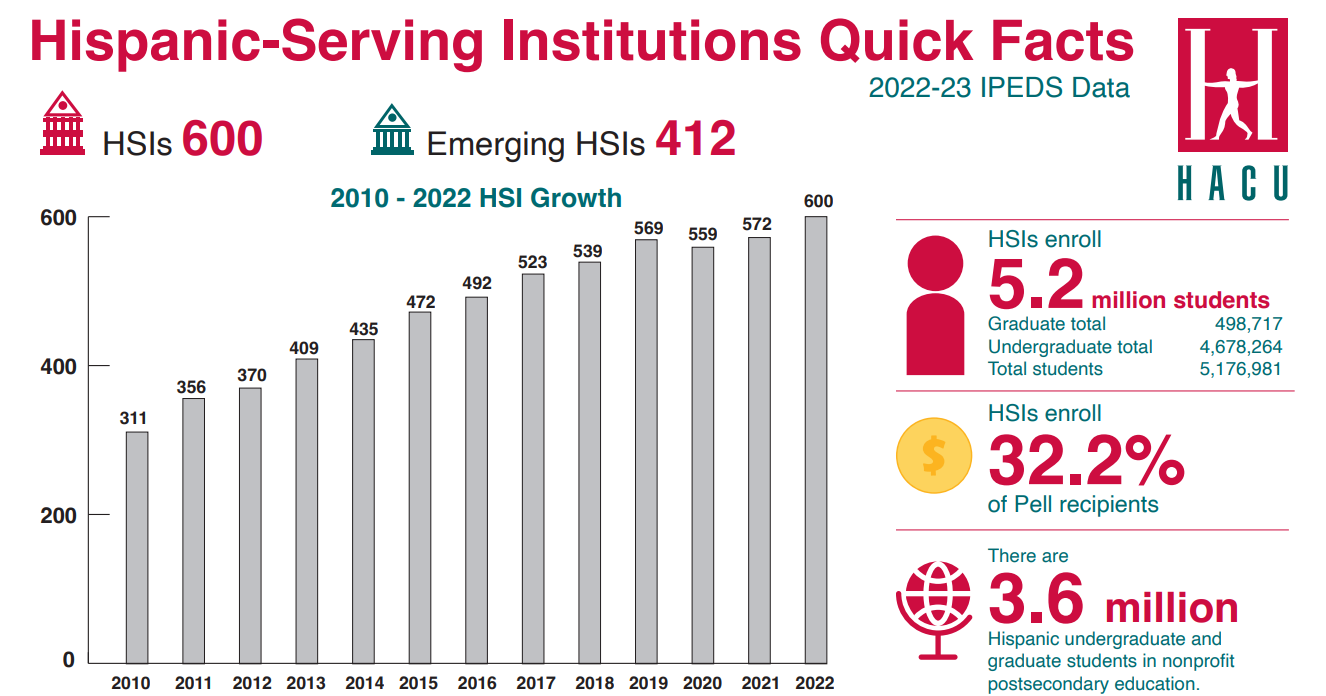
Share On Social!
There are a now 600 U.S. colleges and universities designated as Hispanic-Serving Institutions (HSIs), a 5% increase over last year’s 572 recognized institutions.
HSIs are accredited, degree-granting public or private nonprofit institutions of higher education with 25% or more total undergraduate Hispanic full-time equivalent (FTE) student enrollment.
“The rate that Hispanic-Serving Institutions continue to grow emphasizes their importance to the communities they serve,” said Antonio R. Flores, leader of the Hispanic Association of Colleges and Universities (HACU), in a press release.
Let’s observe the numbers and how this impacts Latino students.
HSIs By the Number
HSIs enroll 5.2 million students and two-thirds of all Latino undergraduates, according to HACU.
As the number of HSIs continue to grow, data found that 60% of HSIs are 4-year institutions and 40% are 2-year institutions. Overall, 69% of HSIs are public and 31% are private.

Emerging HSIs (eHSIs) are “colleges approaching the 25% Hispanic student enrollment threshold, showed growth to be 412 in 2022-23, compared to 400 in 2021or an increase of 3%.”
“While eHSIs do not have the critical mass of Latino student enrollment required to meet the definition of an HSI, these institutions may soon meet the requirement as their enrollment grows and Latino representation increases,” according to Excelencia in Education.
HACU reports that most HSIs are in urban areas and are concentrated geographically, with 82% (489) of these institutions located in seven states and one territory, including:
- California (172)
- Florida (30)
- Illinois (34)
- New Jersey (23)
- New Mexico (24)
- New York (39)
- Texas (111)
- Puerto Rico (56)
Latinos and The Need for HSIs
The Pew Research Center identified racial/ethnic differences in college graduation patterns.
Only 21% of Latino adults have a bachelor’s degree or more education, compared to 61% of Asian Americans, 42% of White, and 28% of Black adults.
A 2021 survey found that Latino adults (52%) were more likely than those who are White (39%) or Black (41%) to say a major reason they didn’t graduate from a four-year college is that they couldn’t afford it.
Similarly, Latino and Black adults were more likely than their White counterparts to say needing to work to support their family was a major reason.
When it comes to graduate degrees, 7% of Latinos 25 and older have a graduate degree.
Despite these numbers, research also found that Latinos in the U.S. have seen the fastest growth in advanced degrees of any major racial or ethnic group.
Latinas have also experienced a 52% rise in college degree attainment at HSIs from 2015-2020.
With this in mind, it’s important to consider the opportunities that HSIs provide for Latino students.
“An HSI designation helps to foster an inclusive culture on campus—one that supports marginalized students from start to finish,” according to the University of Colorado Denver.
Explore a complete list of HSIs here. View the full list of eHSIs here.
“HSIs are engines of upward mobility and are the backbone of educational opportunity for millions of students across the country,” Flores said.
Advocating for Community Health
Education plays a part in your overall health.
How is the state of education – and health – in your community?
Find out by downloading a Salud America! Health Equity Report Card for your town!
The report card auto-generates Latino-focused local data with interactive maps and comparative gauges, which can help you visualize and explore inequities in education, housing, transit, poverty, health care, food, and more.
You will see how your county stacks up compared to your state and nation.
Then you can share the Report Card with your local leaders to advocate for healthy change!
GET YOUR HEALTH EQUITY REPORT CARD!
Explore More:
EducationBy The Numbers
142
Percent
Expected rise in Latino cancer cases in coming years



